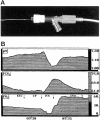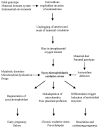Onset of maternal arterial blood flow and placental oxidative stress. A possible factor in human early pregnancy failure
- PMID: 11106583
- PMCID: PMC1885754
- DOI: 10.1016/S0002-9440(10)64849-3
Onset of maternal arterial blood flow and placental oxidative stress. A possible factor in human early pregnancy failure
Abstract
The aim was to measure changes in the oxygen tension within the human placenta associated with onset of the maternal arterial circulation at the end of the first trimester of pregnancy, and the impact on placental tissues. Using a multiparameter probe we established that the oxygen tension rises steeply from <20 mmHg at 8 weeks of gestation to >50 mmHg at 12 weeks. This rise coincides with morphological changes in the uterine arteries that allow free flow of maternal blood into the placenta, and is associated with increases in the mRNA concentrations and activities of the antioxidant enzymes catalase, glutathione peroxidase, and manganese and copper/zinc superoxide dismutase within placental tissues. Between 8 to 9 weeks there is a sharp peak of expression of the inducible form of heat shock protein 70, formation of nitrotyrosine residues, and derangement of the mitochondrial cristae within the syncytiotrophoblast. We conclude that a burst of oxidative stress occurs in the normal placenta as the maternal circulation is established. We speculate that this may serve a physiological role in stimulating normal placental differentiation, but may also be a factor in the pathogenesis of pre-eclampsia and early pregnancy failure if antioxidant defenses are depleted.
Figures









References
-
- Boyd JD, Hamilton WJ: The Human Placenta. 1970. Heffer and Sons, Cambridge
-
- Larsen WJ: Human Embryology. 1997. Churchill Livingstone, New York
-
- Hustin J, Schaaps JP: Echographic and anatomic studies of the maternotrophoblastic border during the first trimester of pregnancy. Am J Obstet Gynecol 1987, 157:162-168 - PubMed
-
- Hustin J, Schaaps JP, Lambotte R: Anatomical studies of the utero-placental vascularisation in the first trimester of pregnancy. Troph Res 1988, 3:49-60
-
- Jauniaux E, Jurkovic D, Campbell S: Current topic: in vivo investigation of the placental circulations by Doppler echography. Placenta 1995, 16:323-331 - PubMed
Publication types
MeSH terms
Substances
Grants and funding
LinkOut - more resources
Full Text Sources
Other Literature Sources
Medical

